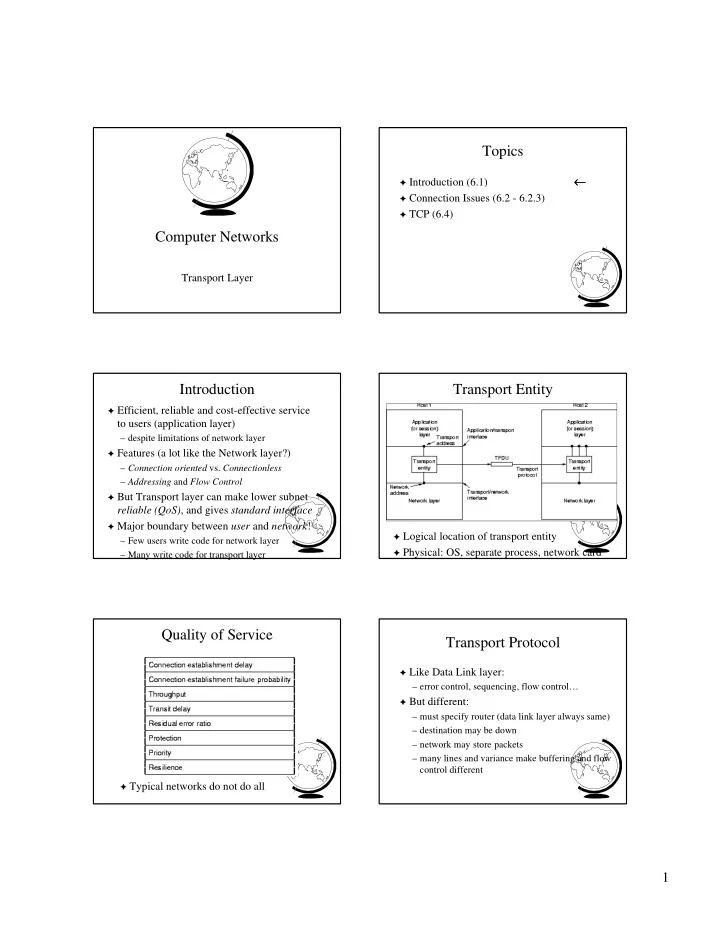

Topics ← ← ! Introduction (6.1) ! Connection Issues (6.2 - 6.2.3) ! TCP (6.4) Computer Networks Transport Layer Introduction Transport Entity ! Efficient, reliable and cost-effective service to users (application layer) – despite limitations of network layer ! Features (a lot like the Network layer?) – Connection oriented vs. Connectionless – Addressing and Flow Control ! But Transport layer can make lower subnet reliable (QoS) , and gives standard interface ! Major boundary between user and network ! ! Logical location of transport entity – Few users write code for network layer ! Physical: OS, separate process, network card – Many write code for transport layer Quality of Service Transport Protocol ! Like Data Link layer: – error control, sequencing, flow control… ! But different: – must specify router (data link layer always same) – destination may be down – network may store packets – many lines and variance make buffering and flow control different ! Typical networks do not do all 1
Finding a Server Finding a Server ! Standard servers wait at well-known port – but what if infrequently used? ! “Connect to a Server” is a Transport level service ! How do you find it? – service mapper - names to transport layer address – name server ! Analogy – how do you find phone number? Three-Way Handshake Establishing a Connection ! Subnet can delay, lose, duplicate packets – Connection can happen twice! CR = Connection Request – Use unique sequence numbers to avoid ! When establish connection, exchange ACK = Connection sequence numbers Accepted – three-way handshake – prevents establishment of unwanted connection Three-Way Handshake Handles Releasing a Connection Problems ! Asymmetric release can result in data loss ! Symmetric release easy? – “I’m done” – “Me, too” 2
Two-Army Problem TCP ! Connection-oriented ! Reliable, end-to-end byte-stream – message boundaries not preserved ! Adapt to a variety of underlying networks ! Robust in the face of failures ! Break data into segments – 64 Kbytes max (often, only 1.5 Kbytes) – 20 byte header ! No safe solution ! Sliding window ! Use 3-way handshake with timers (fig 6-14) TCP Segment Header TCP Transmission Policy Silly Window Syndrome TCP Transmission Policy ! Application reads 1 byte at a time ! Do not have to send immediately – avoid many small packets ! Nagle’s Algorithm – only 1 outstanding byte at a time – fill up, then send – time delay, then send – bad for some apps (X - with mouse movements) ! Fix: only send window when 1/2 full 3
TCP Congestion Control TCP Congestion Control ! Even if sender and receiver agree, still problems ! “Receiver buffer” via receiver’s window ! “Network buffer” via congestion window ! “Effective buffer” is minimum of receiver and network ! Ex: – Receiver says “8k”, Network says “4k” then 8k – Receiver says “8k”, Network says “32k” then 8k Avoiding Congestion TCP Congestion Control ! Network buffer – starts at 1 segment – increases exponentially (doubles) – until timeout or receiver’s window reached – or threshold, then increases linearly – slow start (required by TCP ) ! Internet congestion includes threshold – linear past threshold (called congestion avoidance ) – when timeout, reduce threshold to half of current window and restart slow start N can go up TCP Congestion Control Summary Timer Management ! When below threshold, grow exponentially ! Want to set timeout to minimal value where – slow start segment is known to be lost ! When above threshold, grow linearly – should be just larger than current round-trip – congestion avoidance time (RTT). Why? ! When timeout, set threshold to 1/2 current ! So, need estimate of round-trip time (RTT) window and set window to 1 – how to get it? ! How do you select timer values? ! Why can’t you just measure RTT once and – Important, since timeouts restrict throughput fix timeout timer? – Timer management 4
Enhancement to TCP, or … Timer Management ! Difficult when much variance A Trip to Nevada ! Tahoe (traditional TCP) ! Reno (most TCP implementations) ! Vegas (not yet, but may be coming) ! RTT = α RTT + (1- α )M ( α = 7/8, M ack time) ! + add variance, don’t update on retransmits TCP Reno TCP Tahoe ! If see three duplicate acks, then retransmit ! Tahoe can have long flat periods – fast retransmit – why? 1 2 1 window 3 2 4 2 5 2 2 2 transmission number 6 5 ! Can we avoid some of these long waits? ! And when 3 acks, just halve congestion – Use duplicate acks window and do congestion avoidance – fast recovery TCP Vegas Random Early Drop (RED) ! Tahoe and Reno react to congestion ! Traditional Internet routers ! Vegas attempts to avoid congestion FIFO – detect congestion before loss occurs ! Limitations – lower rate linearly – FIFO cannot detect congestion ! Base detection on increasing RTT until too late ! Instead, detect congestion Window increasing – below min, nothing – above min, then probabilistic – above max, drop all Throughput not ! Note, red average, not instant 5
Non-Responsive Flows and Explicit Congestion Notification Fairness ! Routers use loss as a means of indicating congestion – FIFO can’t help it ! RED Settings: – RED tries to tell TCP flows congestion is qsize = 60 pkts max-th = 30 pkts coming min-th = 15 pkts qweight = 0.002 – implicit max-pro = 0.1 6 ProShare - Unresponsive MM (210Kbps each) ! Instead, routers can indicate congestion ! CBT Settings: 240 FTP-TCP with a bit mm-th = 10 pkts udp-th = 2 pkts – explicit 1 UDP blast (10Mbps, 1KB) ! In acks to sender, better but tough (why?) 0 20 60 110 160 180 (Second) – so on outgoing packets Aggregate TCP Throughput with Aggregate TCP Throughput CBT 6
Recommend
More recommend